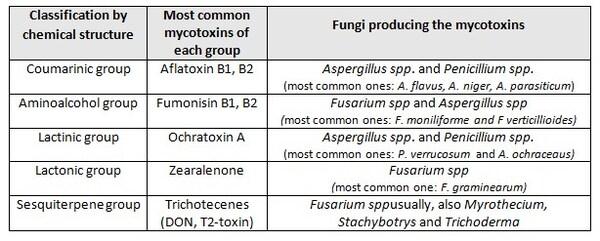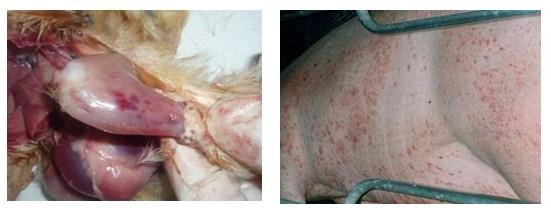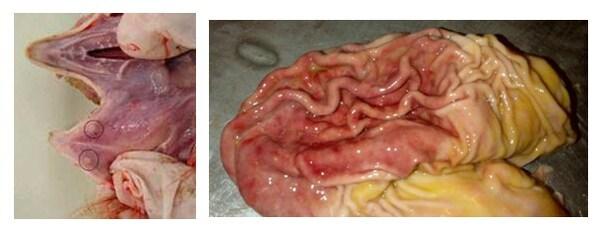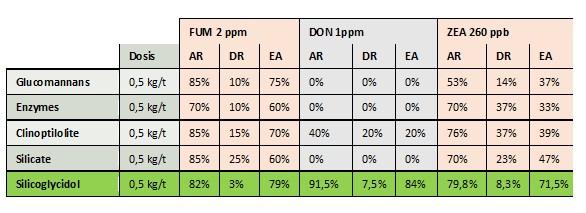Mycotoxins: prevalence on 2020 in South East Asia, signs and lesions, prevention
Published: October 23, 2020
By: Maria Soriano
South East Asia is under a constant increase in the livestock production and, therefore, the demand for raw materials intended for animal feed consumption is rising every year.
Currently, the national production of raw materials for animal feed is not enough to supply the national livestock industry of the area, and the import of grain is needed to ensure feed availability. Corn imports come mainly from Argentina and Brazil, although the import of such grain from China has increased in the last years.
Mycotoxin contamination of raw materials is a ubiquitous problem, as more than 90% of the national and imported grain used for animal feed is contaminated with mycotoxins. In addition, almost 70% of the samples evaluated in the area had a multiple contamination with two or more mycotoxins.
Most prevalent mycotoxins in Southeast Asia during the first half of 2020 were fumonisin, aflatoxin, DON and Zearalenone, which were found over the maximum recommended levels in more than 70% of the samples.
- 1. Clinical picture, lesions and negative effects of mycotoxicosis
The effects on health caused by the mentioned mycotoxins are variable, although all of them may have a great negative impact in productivity and profitability of the farm.
Chemical structure allows to divide mycotoxins in several groups and detail their mechanism of action, the systems affected and the findings that may appear. Despite of this, there are mycotoxins that may cause similar signs and lesions, as it will be stated in this article.
Low mycotoxin contamination levels may show unspecific signs linked to growth retardation and increase in the feed conversion ratio in growing animals, as a direct consequence of the mycotoxin absorption. There may also be an effect on immunity caused by the effect on the liver of some mycotoxins, and a higher predisposition to secondary infections as an indirect consequence. In adult animals, like laying hens, a decrease in egg production and egg weight are usually observed, while abortion may appear in sows.
Severity of the presentation depends on the animal conditions (age, previous health and nutritional status) and also on mycotoxin pattern (synergistic effect of the combination of mycotoxins).
As mentioned initially, the toxic effect of mycotoxins is defined by their chemical structure, following the below classification:

Aflatoxin can inhibit the synthesis of coagulation factors and may cause haemorrhages in internal organs and big muscles, like breast and thighs, visible in live animals as pallorof the eye mucosa, comb and wattles and also skin haemorrhages. In addition, it has a toxic and carcinogenic effect, mainly in the liver and the kidneys.

Left picture: haemorrhages in thighs caused byaflatoxins. Right pictures: skin haemorrhages caused by aflatoxins in swine.
1.1.AMINOALCOHOL GROUP - Fumonisin
Fumonisin is a competitive inhibitor of sphingolipids, which may affect the stability of plasmatic membranes and affects the myelin production. High levels of fumonisin is usually linked to nervous and respiratory symptoms, like pulmonary oedema. In addition, fumonisin action is also visible in liver and kidneys, decreasing the detoxification function and, therefore, boosting the negative effects that other mycotoxins may have.
1.2.LACTONIC GROUP – Zearalenone
Zearalenone is characterized by its estrogenic effects and the derived reproductive problems. Pigs are more sensitive to zearalenone than poultry, and it is common to observe vulvitis, infertility and abortion. In cases of severe contamination, rectal and vaginal prolapse may appear. Post-mortem examination reveals an increase in the uterus size. In poultry, added to the decrease in the egg laying rate, animals may show a higher development of wattles and caruncles.
1.3.SESQUITERPENE GROUP – DON
Deoxynivalenol (DON) may cause feed rejection in monogastric animals in cases of low contamination. Mycotoxins of the sesquiterpene group are able to cause necrosis by contact in the digestive tract. In the case of DON, they are usually visible in the upper digestive tract: mouth and gizzard of poultry, and mouth and stomach in swine. In pigs, vomiting may appear in high contamination cases.

Left picture: ulcers caused by DON in poultry. Right pictures: haemorrhagic lesions in the mucosa of the stomachof a pig caused by DON.
- 2. Prevention of mycotoxicosis - Silicoglycidol
The ubiquity of mycotoxins, as well as the negative effects in productivity, makes prevention of mycotoxicosis an essential factor to be considered in the livestock industry. Prevention strategy is done using mycotoxin binders in feed formulation in order to decrease the effect of mycotoxin contamination by reducing its absorption and promoting its excretion.
There are different types of mycotoxin binders available, although Silicoglycidol is considered the proper solution because of its features.
Silicoglycidol is an optimized and patented molecule designed by Biovet S.A., being the first patent worldwide of a mycotoxin binder. It is based on a silica polymer which receives an ionic and thermal treatment to enhance its structure and binding properties. The treatment applied increases the surface of adsorption of mycotoxins and wides the spectrum of action, allowing to be highly effective at low dosage.
Silicoglycidol captures all range of mycotoxins through hydrogen bonds, which are stable unions that ensure the excretion of mycotoxin without damages in the digestive tract nor absorption by the animal. In addition, the molecule has a selective adsorption, meaning that it is demonstrated that Silicoglycidol does not bind nutrients from the diet, like amino acids and vitamins.
The use of Silicoglycidol has been under a deep research and investigation process to demonstrate its effectivity compared to other mycotoxin binders, either through in vitro evaluations, using artificial digestive systems, and in vivo evaluations, where productivity of the animals is assessed.
2.1. In vitro evaluation of Silicoglycidol
In vitro evaluations in monogastric species are summed up in the following chart, which show that Silicoglycidol has a high adsorption efficiency for the mycotoxins present in South East Asia. This means that Silicoglycidol has a higher rate of binding mycotoxins compared to other binders and, once mycotoxin is captured, hydrogen bondsare resistant to the changes of pH and avoid the detachment of mycotoxins, which are finally eliminated in the faeces.

[AR: Adsorption rate at pH 3; DR: desorption rate at pH 9; EA: efficiency of adsorption: AR-DR]
2.2. In vivo evaluation of Silicoglycidol
A commercial trial is performed to assess the effectivity on productive parameters of Silicoglycidol compared to a non-treated silicate in broilers, under a feed contamination with aflatoxin B1 of 11.5 ppb.

As seen in the chart, Silicoglycidol obtains better results than non-treated silicate while being used at a six-time lower dosage.
In the case of pigs, as an example, the efficacy of Silicoglycidol was evaluated in post-weaned piglets which received a DON-contaminated diet (2.5 ppm). Silicoglycidol group showed a 10% improvement of the FCR. This means that, for each 1000 pigs of that farm, Silicoglycidol helped them to produce 1.5 more tons of meat, while saving 2 tons of feed, which represents a high profitability for the farm.
CONCLUSIONS
The livestock production in Asia keeps increasing yearly, leading to an increase in the feed demand and the need of importation of raw materials to comply with the supply requirements. Either national and imported grain has a high risk of mycotoxin contamination, which require a proper prevention strategy to avoid the mycotoxin-related negative effects on animal performance and farm economy. Aflatoxin, Fumonisin, DON and zearalenone were the most prevalent mycotoxins in grain in the first half of 2020.
Biovet mycotoxin binder line, based on Silicoglycidol, is the most effective solution to work on mycotoxicosis prevention in Southeast Asia, as per demonstrated on in vitro trials and the benefits on productive parameters and savings obtained in commercial evaluations.
Related topics
Authors:
Biovet-Alquermes
Recommend
Comment
Share

Would you like to discuss another topic? Create a new post to engage with experts in the community.








.jpg&w=3840&q=75)